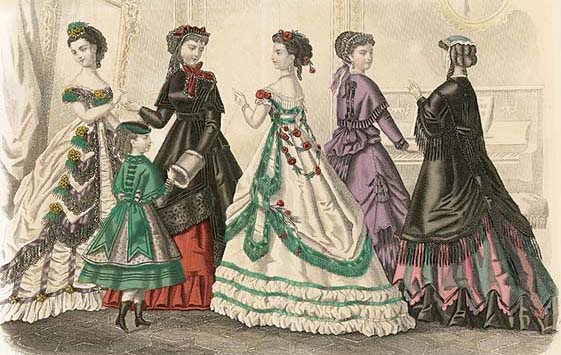
Fashion plate from Godey’s Lady’s Book, c. 1869.
• Leafing through James Baldwin’s 1,884-page FBI file. (Literary Hub)
• In the early 1860s, the editor of Godey’s Lady’s Book used her platform to oppose civil war: “By invoking motherhood and domesticity, Hale made a sustained argument for national unity. She masked her worries about a potential war in stories that exalted how women could influence the actions of men from the sweet domesticity of their own homes. Historical narratives showed mothers gently guiding their men and children toward Hale’s preferred political conclusions. Mournful poetry about dead soldiers and lost sons helped the potential of war hit home—and, conveniently, couldn’t very well be pegged as political.” (JSTOR Daily)
• Moving beyond the white marble sculptures of classical art. (Hyperallergic)
• After being banished from their home by a king to whom they refused to swear fealty, the Brothers Grimm were in desperate need of income. Their plan? “They decided to take up an offer they had previously refused, from a publisher based in Frankfurt. They were to create a dictionary of the German language, a project so massive that by the time Jacob and Wilhelm died (in 1863 and 1859, respectively), they had only completed up through E. When the Deutsches Wörterbuch (The German Dictionary) was finally finished, more than a century later, it became the largest German dictionary ever compiled.” (Atlas Obscura)
• Elaborately designed sleeves are everywhere in women’s fashion right now—just like in the 1830s! Are that decade’s political and social upheavals far behind? (The Hairpin)
• The films of furniture designers Charles and Ray Eames: “The Eameses made branded content. Their clients were IBM, Boeing, Polaroid, Westinghouse, ABC, and Herman Miller, Inc. The films were often made for internal use, to explain products to sellers, or to promote the benevolence of the brand. Since their clients trusted them enough to give them complete creative control, the Eameses may have seen their partnership as a distribution method, a way to reach ‘the most,’ but they were also marketing themselves as a brand. ‘Charles and Ray Eames were especially well-suited partners for America’s progressive industries,’ writes the design historian Donald Albrecht. ‘Young and successful, the Eameses embodied a forward-looking perspective that fit well within the nation’s expanding capitalist economy.’” (Paris Review Daily)